1) Introduction
In this blog post I will explain how to integrate an arbitrary function using Monte Carlo Integration basically we are shooting darts into a dartboard and accepting them according to a given criteria, we can represent this by the following gif:
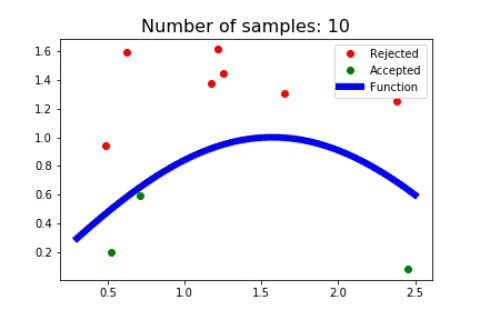
2) Algorithm
In Monte Carlo Integration we sample from an interval ${a,b}$ and see if it is inside the region between the function and the x axis, if this condition is satisfied we accept the sample, otherwise we discart the sample.
So basically we are shooting darts randomly and accepting them if they are inside the area bellow the function that you wish to integrate and the x axis, the mean count of on target darts are multiplied by the area that covers a paralelogram made by the max of your function inside this interval and the size of the interval. The following is the mathematical way that we
Consider that you want to estimate the following integral:
$$ \int_a^b f(x) dx $$
The procedure can be summarized as follows:
- Draw a uniform sample from the interval $x \sim {a,b}$ and a uniform sample from $y \sim \{ 0, \max (f(\{a,b\}) \}$, where $\max (f({a,b})$ is the maximum value of the function inside the interval ${a, b}$ ;
- Evaluate $f(x)$ and if $f(x) > y$ discard the sample, otherwise accept the sample.
On average you will have the number of samples that satisfies your constraints, then you take the average and multiply for the area of your given interval:
$$ A = (\max f(\{a,b\}) - 0)*(b-a) $$
Thus:
$$ \int_a^b f(x) dx = A* \mathbb{E}(\mathrm{Accepted \ counts}) $$
Let’s program this algorithm in python!
import numpy as np
import matplotlib.pyplot as plt
from tqdm import tqdm
def mc_integration(x_init, x_final, func, n=100000):
""" Function to do monte carlo integration for
n samples.
Parameters
-----------------------------------------------
x_init(float): Starting point of integration.
x_final(float): Ending point of integration.
func(function): Python function that you want to integrate.
n(int): Number of samples.
"""
X = np.linspace(x_init, x_final, 1000)
y1 = 0
# Overshoot by 1 for convergence
y2 = max((func(X))) + 1
area = (x_final-x_init)*(y2-y1)
check = []
xs = []
ys = []
for _ in range(n):
# Generate Samples
x = np.random.uniform(x_init,x_final,1)
xs.append(float(x))
y = np.random.uniform(y1,y2,1)
ys.append(float(y))
# Reject
if abs(y) > abs(func(x)) or y<0:
check.append(0)
# Accept
else:
check.append(1)
return np.mean(check)*area, xs, ys, check
Application 1: $f(x) = \sin x$
Let’s try with a simple function:
$$ f(x) = \sin x $$
And compare with the integration used on scipy.
def f(x):
return np.sin(x)
from scipy.integrate import quad
a = 0.3
b = 2.5
sol, xs, ys, check = mc_integration(a, b, f, n=1000000)
id_sol, _ = quad(f, a, b)
print(f'Monte Carlo Solution: {sol}')
print(f'Quad Solution: {id_sol}')
print(f'Error: {np.square(sol - id_sol)}')
Monte Carlo Solution: 1.7552919930712214
Quad Solution: 1.7564801046725398
Error: 1.4116091771873149e-06
Let’s see what is happening when we are doing this procedure, the red dots are rejected and blue dots are accepted and we have the plot of our function in blue.
We see that we sampled a lot of points in this interval such that we almost filled the area.
check = np.array(check)
xs = np.array(xs)
ys = np.array(ys)
plt.plot(xs[check == 0], ys[check == 0], 'ro', label='Rejected')
plt.plot(xs[check == 1], ys[check == 1], 'go', label='Accepted')
x = np.linspace(a,b, 100000)
plt.plot(x, f(x), label='Function', linewidth=6)
plt.legend()
plt.show()
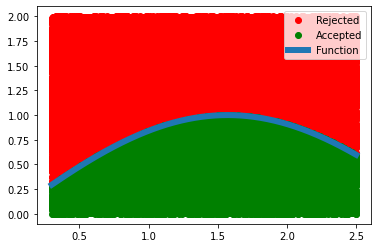
Let’s see how the convergence of our method is affected by the sample size.
err = []
n = np.linspace(10, 10000, 100)
for i in tqdm(n):
sol, *_ = mc_integration(a, b, f, n=int(i))
err.append(np.square(sol - id_sol))
plt.plot(n, err)
plt.title("Convergence", size=20)
plt.xlabel("Number of Samples", size=16)
plt.ylabel("Error", size=16)
plt.show()
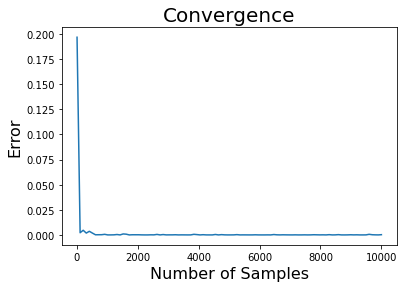
Application 2: $f(x) = \frac{\sin x}{x^2}$
def f(x):
return np.sin(x)/(x**2)
from scipy.integrate import quad
a = 0.3
b = 5
sol, xs, ys, check = mc_integration(a, b, f, n=1000000)
id_sol, _ = quad(f, a, b)
print(f'Monte Carlo Solution: {sol}')
print(f'Quad Solution: {id_sol}')
print(f'Error: {np.square(sol - id_sol)}')
Monte Carlo Solution: 1.773632401526077
Quad Solution: 1.635995393784945
Error: 0.01894394589993242
Let’s see what is happening when we are doing this procedure, the red dots are rejected and blue dots are accepted and we have the plot of our function in blue.
We see that we sampled a lot of points in this interval such that we almost filled the area.
check = np.array(check)
xs = np.array(xs)
ys = np.array(ys)
plt.plot(xs[check == 0], ys[check == 0], 'ro', label='Rejected')
plt.plot(xs[check == 1], ys[check == 1], 'go', label='Accepted')
x = np.linspace(a, b, 100000)
plt.plot(x, f(x), label='Function', linewidth=6)
plt.legend()
plt.show()
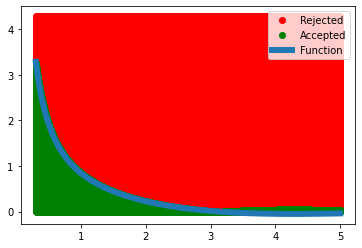
As before, let’s see the convergence of our method:
err = []
n = np.linspace(10, 10000, 100)
for i in tqdm(n):
sol, *_ = mc_integration(a, b, f, n=int(i))
err.append(np.square(sol - id_sol))
100%|██████████| 100/100 [00:06<00:00, 15.33it/s]
plt.plot(n, err)
plt.title("Convergence", size=20)
plt.xlabel("Number of Samples", size=16)
plt.ylabel("Error", size=16)
plt.show()
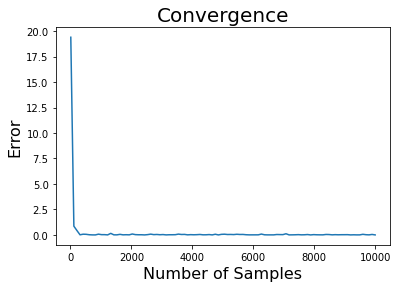
Conclusion
By learning the method of Monte Carlo Integration you have learned a powerful tool that can be generalized for other algorithms such as Sequential Monte Carlo(SMC) and Markov Chain Monte Carlo(MCMC), which (hopefully) I will cover in future blog posts.